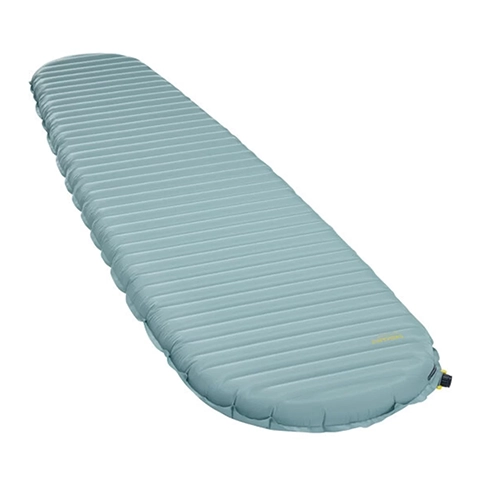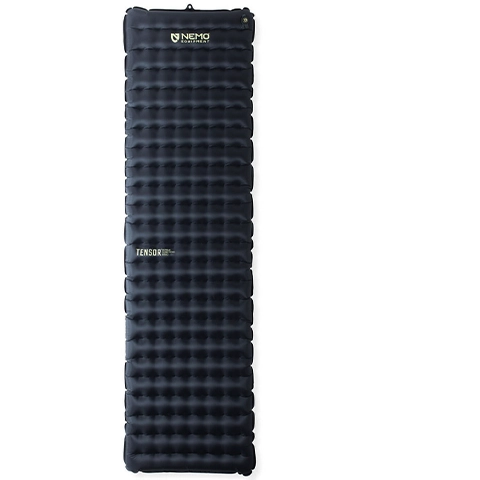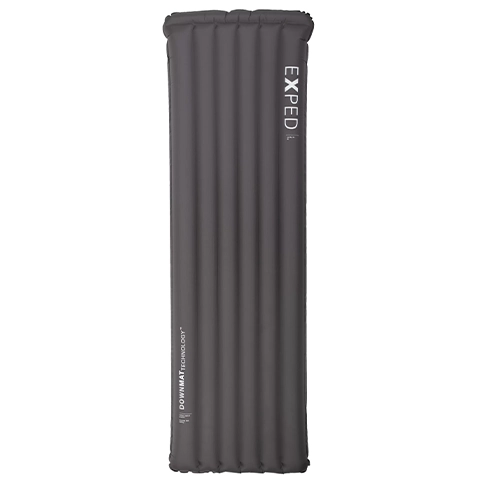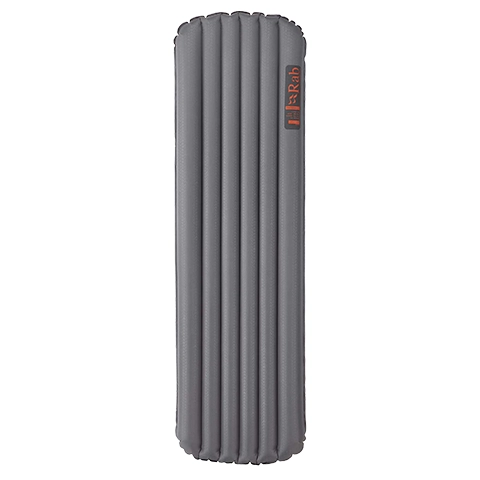

When braving winter backcountry trips, a quality sleeping pad is crucial for staying warm through cold nights.
Selecting from the many options requires weighing attributes like insulation, weight, R-value, durability and brand reputation.
However, with so many sleeping pad options on the market, determining the best fit can feel daunting.
Don’t worry! This guide evaluates top-rated winter sleeping pads based on their reviewed performance in key areas like weight, warmth, and durability.
By understanding the top considerations, you can feel confident choosing one of the best winter sleeping pads for your needs and upcoming adventures.
Let’s get started.

Key Specs
Weight: 16.12 ounces (457 grams)
R-Value: 7.3
Price: $$$
PROS
✅ Ultralight
✅ Quieter than previous model
CONS
❌ Still a bit noisy
The XTherm NXT delivered impressive warmth and comfort during recent winter trips where overnight temperatures dropped well below freezing.
Its innovative Triangular Core Matrix construction and ThermaCapture technology generated a remarkable R-value of 7.3.
We were pleasantly surprised by how well-insulated the 3-inch thick pad kept us, eliminating any chances of heat loss to the frozen ground. Its horizontal baffling structure provided supportive cushioning throughout the night. The 70D nylon fabric felt robustly durable for extended expedition use.
Inflation and deflation with the WingLock valve proved quick and effortless, a noteworthy improvement over the previous model’s propensity for noisy air escape. At only 3.5L packed volume, it maximized valuable sled and pack space.
Overall, the XTherm NXT delivered top-tier performance befitting its premium price tag. For serious cold-weather pursuits demanding ultralight insulation that won’t fail, it offers unparalleled protection from wilderness elements. The only downside is that it can be noisy when moving around at night.

Key Specs
Weight: 17.88oz (507g)
R-Value: 8.5
Price: $$$
PROS
✅ Ultralight
✅ Quiet
CONS
❌ Limited sizes for the mummy-shaped pad
The Tensor EC delivers incredible warmth and comfort for backcountry winter camping. Featuring NEMO’s innovative Apex baffle construction, it achieves an impressive R-value of 8.5.
Four layers of Thermal Mirror film are strategically placed within the baffles to maximize insulation. On a recent trip where overnight temps dropped below 0°F, the Tensor kept us incredibly warm – our tent condensation froze while we stayed cozy inside quilts and bags on the pad.
At 3.5″ thick, it provided plush cushioning from frozen ground. And unlike other high-R pads, it remained impressively quiet – allowing undisturbed sleep.
40D nylon on the bottom and 20D on top proved puncture-resistant and smooth. The updated Laylow valve inflated and deflated with ease, even with gloves on.
A nice bonus was how quickly the black top layer absorbed heat from our bodies. While packed size and included Vortex pump made set-up a breeze, availability in mummy or one-size-fits-all designs could be limiting for some users.
Overall, the regular shaped Tensor EC delivers peerless warmth, quiet, and comfort in a trim package that maximizes backcountry joy even in brutal winter conditions.

Key Specs
Weight: 17.67 ounces (501 grams)
R-Value: 7.1
Price: $$
PROS
✅ Minimal noise
✅ Good for side sleepers
CONS
❌ Hard to pack
The Ultra 7R delivers outstanding warmth, comfort and packability ideal for winter backpacking trips. Featuring Exped’s innovative DOWNMAT TECHNOLOGY and 700cuin of down insulation, this pad keeps sleepers cozy down to freezing conditions.
At 2.75 inches thick, the air cushion fully cradles the body while welded baffles prevent cold spots. Air chambers run head-to-toe to support proper spinal alignment all night long.
The recycled 20D ripstop fabric is plenty durable, yet the pad compresses very small thanks to its Schnozzel pump sack. Inflation and deflation are breeze with the large, reliable FlatValves.
Down insulation retains excellent warmth even when compressed, so it stored comfortably in our pack without bulk. That said, cramming the fully deflated pad back into its stuff sack can be a chore requiring some wrestling.
Overall, the Ultra 7R delivered unrivaled backcountry comfort with a wide range of available lengths and widths to suit diverse sleepers. Its excellent warmth and packability make it a top winter backpacking pad choice.

Key Specs
Weight: 26.10 ounces (740 grams)
R-Value: 5
Price: $$$
PROS
✅ Features down fill
✅ Durable
CONS
❌ Hard to pack
❌ A bit heavy
Engineered to endure challenging outdoor journeys, the Mountain Equipment Aerostat sleeping pad proves its resilience.
With its sturdy build and specialized valve, it emerges as a reliable choice for ultralight backpackers seeking enduring effectiveness.
Furthermore, the incorporation of down insulation and a Windsock inflator elevates its comfort and user-friendliness.
When facing cold climates, this pad truly shines, providing a degree of comfort that aligns with or even surpasses its description. It’s worth noting that some users might encounter difficulty with the size of the included stuff sack.
Nevertheless, our overall satisfaction with the pad’s robustness and design remains strong.

Key Specs
Weight: 27.69 ounces (785 grams)
R-Value: 5.5
Price: $
PROS
✅ Comfortable
✅ Relatively affordable
CONS
❌ Heavy and a bit bulky
❌ Noisy
The Rab Stratosphere 5.5 performed excellently during winter trips, delivering exceptional insulation thanks to its recycled Stratus R insulation.
Setup and takedown are breeze with the convenient pump sack and two-way valve. Oversized chambers kept us properly positioned throughout comfortable nights.
Where this pad truly excelled was insulating us down to freezing overnight temps. We stayed toasty inside our sleeping bags thanks to its effective trapping of body heat. Unfortunately, a small downside is that it can be somewhat noisy when shifting positions at night, which wasn’t an issue on some other pads we’ve used.
In addition, while still quite packable for its high 5.5 R-value insulation, it does require a slightly larger pack size than some competitors. Not a major difference, but something to be aware of if minimizing bulk is a top priority.
Overall though, this remains a terrific ultralight winter sleeping pad choice for those on a budget.
When selecting an ultralight sleeping pad for winter backpacking, consider these key factors:
Insulation (R-Value)
Aim for a minimum R-value of 4-5 for 3-season car camping down to 15°F. R5-7 provides sufficient warmth for shoulder season backpacking. R7-10 excels down to 0°F for serious winter trips. The higher the R-value, the better the pad resists heat loss through conduction.
Durability
Consider abrasion areas like knees, hips, shoulders. 40-70D nylon withstands rough use best but adds ounces. 30-40D works well for hiking. Lighter 20-30D risks punctures on rough surfaces. Choose based on terrain and your level of wear.
Weight
15-30oz balances insulation and packability well in most scenarios. Under 15oz provides little padding and warmth potential. Over 30oz packs down quite large, limiting other gear. Stay within your preferred pack weight range.
Dimensions
Width matters for side and stomach sleepers seeking full spinal alignment. 14-18″ is adequate for many but limits movement. 20″+ offers optimum comfort but also bulk. Length depends on your height plus room for feet.
Fabric Density
Higher deniers like 40-70D are most durable overall but add ounces. 30-40D handles abrasion well with reasonable weight. 20-30D suffices for gentle trails if weight is a priority. Under 20D risks tears from branches and rocks.
For more detailed information on choosing a sleeping pad, explore our in-depth post here.
How to choose the best winter sleeping pad for your adventure? Consider insulation (aim for R5+), durability, weight (15-30oz balance), and dimensions (20″+ width for comfort), as well as fabric density based on conditions. Look for an inflatable lightweight option around 25oz that will keep you warm down to 0 degrees F when paired with a quality winter sleeping bag, whether you’re car camping or backpacking – balancing insulation, packability, and your individual needs is essential for cozy winter adventures.
Which is better for winter camping – inflatable or foam sleeping pads? Inflatable pads pack down much smaller than closed-cell foam mattresses, making them far more lightweight and packable for backcountry adventures. However, foam pads provide rigid insulation without needing inflation and are less prone to failure in freezing temperatures. Overall, an inflatable sleeping pad paired with a insulating closed-cell foam camping pad or sit pad provides the optimal combination of packability, insulation, and protection from cold ground for cozy winter nights under the stars.
While a summer sleeping pad may seem to suffice in a pinch for winter camping, it likely will not provide the necessary insulation one needs in seriously cold conditions. Summer pads usually have an R-value of 3 or lower, meaning they do little to prevent heat loss through conduction to the frozen ground below. Without adequate insulation from the ground, it can be difficult to stay warm throughout the long winter nights, even with multiple sleeping layers on top. Additionally, summer pads often use thinner and less durable materials that may puncture or tear more easily on rough terrain when covered in ice or snow. They also may not have reinforced baffles to prevent cold spots from developing.